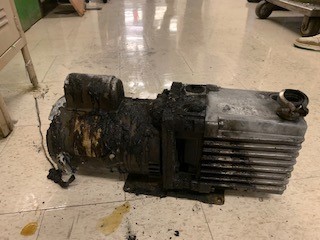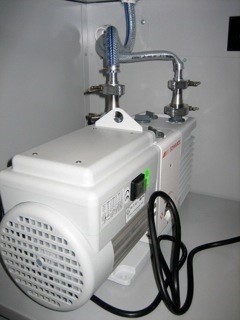Last Revised: April 25, 2022


Revision 10/21/2021
On the evening of August 14, 2020, a Chemistry graduate student was attempting to evaporate ethyl acetate and hexane using a Buchi Rotavapor (R-200) connected to a Savant VP100 rotary-vane roughing pump. The vacuum pump was located in a designated pump cabinet in the base of the fume hood, and power to the cabinet was controlled by a toggle switch on the face of the fume hood.
The student was alone in the lab at 6:30 PM when he engaged the power switch on the hood to turn on the vacuum pump. He reports that the vacuum monitor on the rotary evaporator indicated that the pump was not supplying vacuum, so he turned off the power switch. When he flipped the switch back on, he heard “a loud bang” and saw the cabinet door “burst open.” The vacuum pump was on fire, producing orange flames and black smoke.
The student was not standing in front of the cabinet when the explosion occurred and, as a result, was uninjured. The fire alarm was activated, and the fire department extinguished the fire using water.
Based on the information provided by the witnesses and responders, the most likely direct cause of the explosion was the ignition of an explosive concentration of diethyl ether vapor expelled from the pump exhaust. The source of ignition may have been either a spark from the pump motor or from the cooling fan inside the cabinet, both of which are controlled by the same power switch. Diethyl ether, which was evaporated using this system earlier in the day, may have been pulled into the vacuum pump and then been exhausted into the cabinet. The vapor from the pump exhaust could have ignited when the student flipped the toggle switch to energize the pump and cooling fan.
Lessons Learned
-
All vacuum exhaust must be properly vented and include sufficient condensing capacity prior to the pump. The exhaust ports of pumps stored in vacuum pump cabinets must be connected directly to the vent port inside the cabinet. The pump may not vent into the cabinet interior. See photo for example of proper setup.

Note: This photo does not show an oil mist-separator on the vacuum exhaust. Oil mist separators are required for high vacuum pumps. Contact us at ehrs@ehrs.upenn.edu if you have any questions about your vacuum pump set-up.
-
Any rotary evaporator systems that are using rotary vane pumps should be reviewed to determine whether the vacuum pressure is appropriate to the application and is well controlled. A less powerful vacuum pump with more precise vacuum control (such as a diaphragm pump) is more appropriate for rotary evaporation of low boiling solvents. Diaphragm pumps offer advantages including their small size, chemical-resistance, and ability to fit next to the rotavapor in the fume hood. For guidance on selecting the best vacuum pump for your application, see Labconco’s “How to Select the Right Vacuum Pump” and “Lab Manager Magazine’s Independent Guide to Purchasing a Vacuum Pump.”
-
It is important to select the right pressure and temperature when condensing solvent vapor in rotary evaporation. For a sufficient condensation of the vapor, you should set the cooling temperature at about 20°C lower than the vapor temperature. This is known as the “Delta 20 Rule”: set the bath temperature at 50°C to yield a solvent vapor temperature of 30°C, which is subsequently condensed at 10°C. Sigma-Aldrich Labware Notes. (2007). The “Golden Rule” for Solvent Removal for more information. Also, refer to the following Buchi recommendations for rotavap use and optimal settings (See section 5.8 in the BÜCHI Rotavapor R-200/205 manual.)
-
See Fact Sheet: Vacuum Pump Use and Installation for guidance on vacuum pump maintenance requirements. Keep detailed records of all pump maintenance including routine maintenance and vendor-provided services.
-
Use a second cold trap between the pump and the experiment to minimize the amount of volatile chemicals reaching the pump. This will also help to protect the pump from damage caused by degradation and contamination of the pump oil. See Fact Sheet: Vacuum Pump Use and Installation for more information about pump setup and use of cold traps.
-
Empty the condenser trap immediately after evaporation is complete to eliminate the possibility that solvent will evaporate as the condenser warms to room temperature.
Issued 9/20